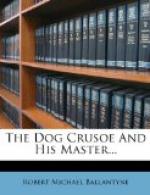A troop of about thirty wild horses appeared, as he spoke, on the brow of a ridge, and advanced slowly towards them.
“Hist!” exclaimed Joe, reining up; “hold on, lads. Wild horses! my rifle to a pop-gun there’s wilder men on t’other side o’ them.”
“What mean you, Joe?” inquired Dick, riding close up.
“D’ye see the little lumps on the shoulder o’ each horse?” said Joe. “Them’s Injun’s feet; an’ if we don’t want to lose our scalps we’d better make for the forest.”
Joe proved himself to be in earnest by wheeling round and making straight for the thick wood as fast as his horse could run. The others followed, driving the pack-horses before them.
The effect of this sudden movement on the so-called “wild horses” was very remarkable, and to one unacquainted with the habits of the Camanchee Indians must have appeared almost supernatural. In the twinkling of an eye every steed had a rider on its back, and before the hunters had taken five strides in the direction of the forest, the whole band were in hot pursuit, yelling like furies.
The manner in which these Indians accomplish this feat is very singular, and implies great activity and strength of muscle on the part of the savages.
The Camanchees are low in stature, and usually are rather corpulent. In their movements on foot they are heavy and ungraceful, and they are, on the whole, a slovenly and unattractive race of men. But the instant they mount their horses they seem to be entirely changed, and surprise the spectator with the ease and elegance of their movements. Their great and distinctive peculiarity as horsemen is the power they have acquired of throwing themselves suddenly on either side of their horse’s body, and clinging on in such a way that no part of them is visible from the other side save the foot by which they cling. In this manner they approach their enemies at full gallop, and, without rising again to the saddle, discharge their arrows at them over the horses’ backs, or even under their necks.
This apparently magical feat is accomplished by means of a halter of horse-hair, which is passed round under the neck of the horse and both ends braided into the mane, on the withers, thus forming a loop which hangs under the neck and against the breast. This being caught by the hand, makes a sling, into which the elbow falls, taking the weight of the body on the middle of the upper arm. Into this loop the rider drops suddenly and fearlessly, leaving his heel to hang over the horse’s back to steady him, and also to restore him to his seat when desired.
By this stratagem the Indians had approached on the present occasion almost within rifle range before they were discovered, and it required the utmost speed of the hunters’ horses to enable them to avoid being overtaken. One of the Indians, who was better mounted than his fellows, gained on the fugitives so much that he came within arrow range, but reserved his shaft until they were close on the margin of the wood, when, being almost alongside of Henri, he fitted an arrow to his bow. Henri’s eye was upon him, however. Letting go the line of the pack-horse which he was leading, he threw forward his rifle; but at the same moment the savage disappeared behind his horse, and an arrow whizzed past the hunter’s ear.




